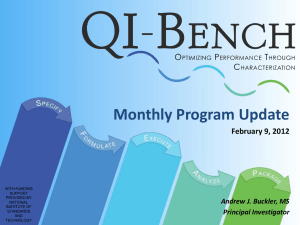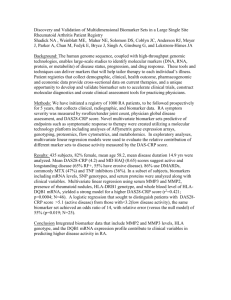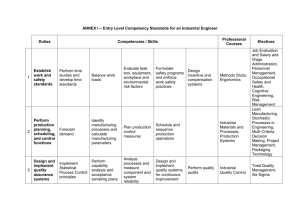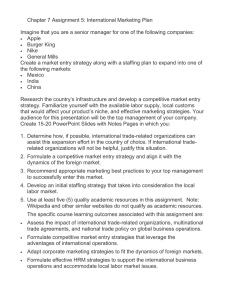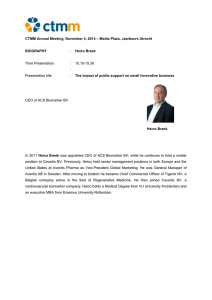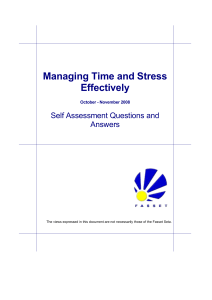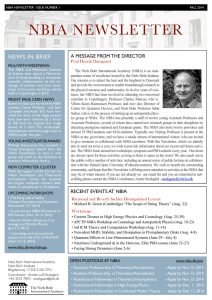QI-Bench_F2F_11-15
advertisement
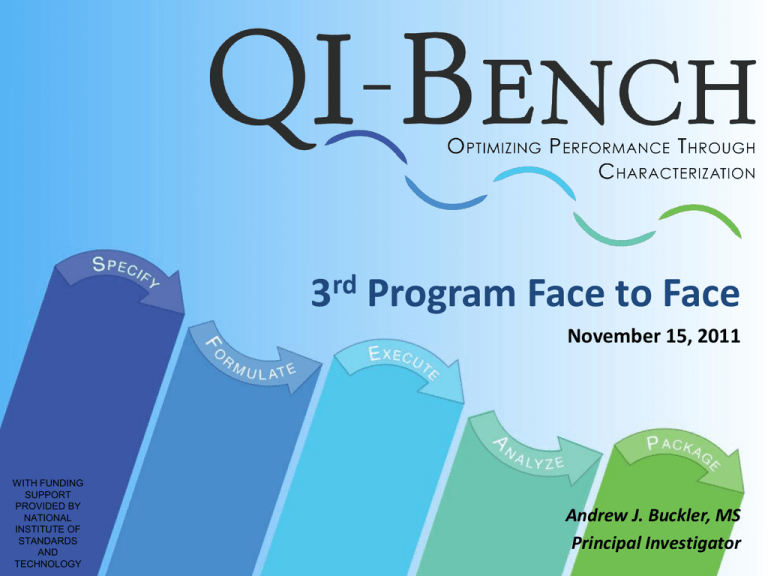
3rd Program Face to Face November 15, 2011 WITH FUNDING SUPPORT PROVIDED BY NATIONAL INSTITUTE OF STANDARDS AND TECHNOLOGY Andrew J. Buckler, MS Principal Investigator Value proposition of QI-Bench • Efficiently collect and exploit evidence establishing standards for optimized quantitative imaging: – Users want confidence in the read-outs – Pharma wants to use them as endpoints – Device/SW companies want to market products that produce them without huge costs – Public wants to trust the decisions that they contribute to • By providing a verification framework to develop precompetitive specifications and support test harnesses to curate and utilize reference data • Doing so as an accessible and open resource facilitates collaboration among diverse stakeholders 2 QI-Bench Structure / Acknowledgements • • Prime: BBMSC (Andrew Buckler, Gary Wernsing, Mike Sperling, Matt Ouellette) Co-Investigators – – • • Financial support as well as technical content: NIST (Mary Brady, Alden Dima, Guillaume Radde) Collaborators / Colleagues / Idea Contributors – – – – – – • FDA (Nick Petrick, Marios Gavrielides) UCLA (Grace Kim) UMD (Eliot Siegel, Joe Chen, Ganesh Saiprasad) VUmc (Otto Hoekstra) Northwestern (Pat Mongkolwat) Georgetown (Baris Suzek) Industry – – • Kitware (Rick Avila, Patrick Reynolds, Julien Jomier, Mike Grauer) Stanford (David Paik, Tiffany Ting Liu) Pharma: Novartis (Stefan Baumann), Merck (Richard Baumgartner) Device/Software: Definiens (Maria Athelogou), Claron Technologies (Ingmar Bitter) Coordinating Programs – – RSNA QIBA (e.g., Dan Sullivan, Binsheng Zhao) Under consideration: CTMM TraIT (Henk Huisman, Jeroen Belien) 3 QI-Bench is Use case Driven Create and Manage Semantic Infrastructure and Linked Data Archives Create and Manage Physical and Digital Reference Objects Core Activities for Biomarker Development Collaborative Activities to Standardize and/or Optimize the Biomarker Consortium Establishes Clinical Utility/Efficacy of Putative Biomarker Commercial Sponsor Prepares Device/Test for Market 4 Reference Data Set Manager Reference Data Sets, Annotations, and Analysis Results QIBO Quantitative Imaging Specification Language Batch Analysis Service 3. Batch analysis scripts Source of clinical study results UPICT Protocols, QIBA Profiles, entered with Ruby on Rails web service T Protocols, QIBA es, literature rs and other es 4. Output QIBO(red edges represent biostatistical generalizability) Clinical Body of Evidence BatchMaketo enable (formatted Scripts SDTM and/or other standardized registrations 5 Reference Data Set Manager Batch Analysis Service Reference Data Sets, Annotations, and Analysis Results QIBO 3. Batch analysis scripts Source of clinical study results Quantitative Imaging Specification Language UPICT Protocols, QIBA Profiles, entered with Ruby on Rails web service 4. Output QIBO- T Protocols, QIBA es, literature rs and other es (red edges represent biostatistical generalizability) • Specify context for use and assay methods. • Use consensus terms in doing so. Specify Formulate • Assemble applicable reference data sets. • Include both imaging and non-imaging clinical data. • Compose and iterate batch analyses on reference data. • Accumulate quantitative read-outs for analysis. Execute Analyze • Characterize the method relative to intended use. • Apply the existing tools and/or extend them. Clinical Body of Evidence (formatted to enable BatchMake SDTM and/or other standardizedScripts registrations • Compile evidence for regulatory filings. • Use standards in transfer to regulatory agencies. Package 6 •Specify context for use and assay methods. •Use consensus terms in doing so. Specify QIBO, AIM, RadLex/ Snomed/ NCIt; built using Ruby on Rails. Formulate •Assemble applicable reference data sets. •Include both imaging and non-imaging clinical data. caB2B, NBIA, PODS data elements, DICOM query tools. •Compose and iterate batch analyses on reference data. •Accumulate quantitative read-outs for analysis. Execute MIDAS, BatchMake, Condor Grid; built using CakePHP. Analyze •Characterize the method relative to intended use. •Apply the existing tools and/or extend them. MVT portion of AVT, reuseable library of R scripts. •Compile evidence for regulatory filings. •Use standards in transfer to regulatory agencies. Package STDM standard of CDISC into repositories like FDA’s Janus. 7 BSD-2 license Domain is www.qi-bench.org. Landing page provides • Access to prototypes, • Repositories for download and development, • Acknowledgemen ts, • Jira issue tracking, and • Documentation 8 Project wiki includes sections for • Project management plan, • User needs analysis (including use cases), • Lab Protocol, • Developer’s helps (including use of Git), • Meeting minutes, and • Discussion of investigators/ collaborators. 9 Specify: Specify is presently a composite of QISL and the AIM template builder. The Quantitative Imaging Specification Language (QISL) uses the Quantitative Imaging Biomarker Ontology (QIBO) and other linked ontologies to develop a triple store based on user Q/A. 10 Quantitative Imaging Biomarker Ontology (QIBO) • Initial curation to collect terms: reviewed 126 articles across 6 therapeutic areas elaborating 225 imaging markers • Reusing other publicly available ontologies: MeSH, NCI thesaurus, GO, FMA, and BIRNLex • Current sate: 490 classes and relationship properties for clinical context for use and assay methods. • Next steps: Basic Formal Ontology (BFO) as an upper ontology that provides a formal structure of upper level abstract classes that has been adapted by the Open Biological and Biomedical Ontologies (OBO) foundry, a large collaborative effort for the goal of creating orthogonal and interoperable ontologies in biomedical research. 11 Specify (cont) The idea is that AIM templates would be constructed and linked to the other specification information from the ontologies. Presently it just coexists in the prototype app, it is not yet functionally integrated as ultimately intended. 12 Formulate Web-enabled service for aggregating reference data based on endpoints 13 Formulate (continued) • One small part of Formulate that we have done is to create a CQL “connecter” to import data from NBIA. The reason we do this is to optimize storage for grid computing and to include metadata storage needed to run experiments. 14 15 Endpoints for Formulate Execute is where analyses of Reference Data Sets take place. It is based on MIDAS and the associated Batchmake” capability but extends it for QIBench. The storage model is optimized for metadata storage and grid computing. 16 Execute First Reference Data Sets • Pilot 3A – 156 lesions for evaluation (1A read 15) • Pivotal 3A – 408 lesions for evaluation (1A read 40) • Study 1C – 2364 lesions for evaluation (1C is set to read 66) • Study 1187 – 7122 lesions for evaluation • Available: RIDER, IDRI, MSKCC “1B”, … 17 Execute roadmap • Script to write “Image Formation” content into Biomarker Database for provenance of Reference Data Sets: Application for pulling in data from the “Image Formation” schema to populate the biomarker database. This data will originate from the DICOM imagery imported into QI-Bench. • Laboratory Protocol for the NBIA Connector and Batch Analysis Service: Laboratory protocol to describe the use of the NBIA Connector and the Image Formation script to import data into QIBench and use of the Batch Analysis Service for server-side processing. • Support change analysis biomarkers serial studies (up to two time points in the current period, extensible to additional in subsequent development iterations): Support experiments including at minimum two time points. An example of this is the change in volume or SUV, rather than (only) estimation of the value at one time point. • • Document and solidify the API harness for execution modules of the Batch Analysis Service: This task will include the documentation and complete specification of the Batchmake Application API. Support scripted reader studies: Support reader studies through worklist items specified via AIM templates as well as Query/Retrieve via DICOM standards for interaction with reader stations. ClearCanvas will serve as the target reader station for the first implementation. • Generate output from the LSTK module via AIM template (as opposed to hardcoded): Generate annotation and image markup output from reference algorithms (i.e., LSTK for volumetric CT and Slicer3D for SUV) based on AIM templates instead of the current hard-coded implementation. An AIM Template is an .xsd file. • Re-work the NBIA Connector to run in the context of Formulate: This task will include refactoring and stabilization of the NBIA Connector in order to incorporate its functionality into Formulate. 18 Analyze Current Prototype Capabilities 19 Analyze MVT provides good framework, but with gaps • • • • Lesion tracking Other modalities and measures, e.g., SUV via FDG-PET Properly functioning multiple regression and N-way ANOVA Support Clinical Performance assessment (i.e., in addition to current Technical Performance) – Outcome studies – Integrated genomic/proteomic correlation studies – Group studies for biomarker qualification • • • • Serial studies / change analysis Persistent database Scale-up to handle thousands of cases (10’s thousands of lesions) Deploy as Web app 20 Analyze Figures of Merit and Descriptive Statistics • Collaborative activity underway to converge definitive descriptive statistics for technical and clinical performance • Approaches to defining and administering compliance in relationship with QIBA profiles. Mid-term Process the lesion reads on the same 40 lesions used in the 1A pivotal as a 7th reader using 1A STATA method and compare results. 3. Process the 6 selected lesions from the MVT demonstrator using Perform and analyze the 1A STATA method and compare results. [MVT<->1A STATA] other studies (e.g., 4. Process the lesion reads on the same 6 lesions used in the MVT 1C, 3A, 1187, other th demo set as a 7 reader and compare results. [QI-Bench<->MVT] modes, etc. using 5. Convert 1A STATA analysis to R and compare the results on the STATA analysis 408. [STATA<->R] method. 6. Extend MVT to use the created R scripts (and fill other gaps). 7. Re-do analyses to verify that results come out the same. Convert to R-based, MVT-implemented analysis. As Funding Allows Completion of tool box to include all of the descriptive statistics determined in the discussions / workshops. Done Next-up 1. 21 Package Structure submissions according to eCTD, HL7 RCRIM, and SDTM Section 2 Summaries 2.1. Biomarker Qualification Overview 2.1.1. Introduction 2.1.2. Context of Use 2.1.3. Summary of Methodology and Results 2.1.4. Conclusion 2.2. Nonclinical Technical Methods Data 2.2.1. Summary of Technical Validation Studies and Associated Analytical Methods 2.2.2. Synopses of individual studies 2.3. Clinical Biomarker Data 2.3.1. Summary of Biomarker Efficacy Studies and Associated Analytical Methods 2.3.2. Summary of Clinical Efficacy [one for each clinical context] 2.3.3. Synopses of individual studies Section 3 Quality <used when individual sponsor qualifies marker in context of a specific NDA> Section 4 Nonclinical Reports 4.1. Study reports 4.1.1. Technical Methods Development Reports 4.1.2. Technical Methods Validation Reports 4.1.3. Nonclinical Study Reports (in vivo) 4.2. Literature references Section 5 Clinical Reports 5.1. Tabular listing of all clinical studies 5.2. Clinical study reports and related information 5.2.1. Technical Methods Development reports 5.2.2. Technical Methods Validation reports 5.2.3. Clinical Efficacy Study Reports [context for use] 5.3. Literature references 22 Package Standards Mapping Domain SDTM Variabl e Name Variabl e Label Definiti on DM BRTHDT C Patients Date of Birth Date/ti me of birth of subject CDASH/SDTM Variables ACRIN DICOM NBIA Data Element BRIDG Data type (0010, 0030) Patient' s Date of Birth Biologic Entity. birthDa te* CHAR* ACRIN Reference DICOM Tag NBIA DE Control led Terms, Codelis t or Format NA Role Implem entatio n Notes Record Qualifie r Permiss ible Point to NCIt, RadLex, etc. here ISO8601 & 21090 Core SDTM Role 23 Package NCI – CPATH – CDISC CRF WG 24 Package Web-enabled service for compiling results 25 Open source model • www.qi-bench.org domain • BSD license • Extending rather than forking assets – Engaging with CBIIT OSDI program • QI-Bench specific assets in publicly accessible repositories and full access to development tools through www.qi-bench.org • Project wiki at www.qi-bench.org/wiki 26 Development Lifecycle Process for Centrally Developed Portions High-level relationship among development processes (modeled after corresponding process flow at caBIG to allow effective integration) 27 QI-Bench Developer’s Resources 28 29 Year Outlook Time frame Content October 2011 • • • 3A Pilot data curation Specify feasibility established with proof of concept using BioPortal and QIBO Data center upgrades (now including 24 Processor cores, 40 GB Main Memory, 12 TB Disk storage, Linux, Windows Server, and Mac OS X) November 2011 • • • QI-Bench developer environment (Git, Jira, dashboards) Execute upgrade 3A Challenge Launch December 2011 • • “Image Formation”: scripts and spreadsheet for provenance of Reference Data Sets Laboratory Protocol (Formulate, Execute, Analyze) January 2012 • Support change analysis / serial studies (up to two time points, extensible to additional in subsequent development iterations) (Formulate, Execute, Analyze) February 2012 • • Specify working model (including QIB Ontology and AIM template builder 18 or 23 as possible) Document and solidify the API harness for execution modules of the Batch Analysis Service (Execute) March 2012 • Drive reading stations by making worklist items from within Batchmake scripts (Formulate, Execute) April 2012 • Support DICOM Query/Retrieve from Reference Data Set Manager (to complete the Reader Studies support package) (Execute, Analyze) May 2012 • Extend harness API for AIM templates (including generate output from the LSTK module via AIM template) (Execute) Summer 2012 • Formulate working model (including re-worked NBIA Connector and other content as above) 30 Summary: QI-Bench Contributions • We make it practical to increase the magnitude of data for increased statistical significance. • We provide practical means to grapple with massive data sets. • We address the problem of efficient use of resources to assess limits of generalizability. • We make formal specification accessible to diverse groups of experts that are not skilled or interested in knowledge engineering. • We map both medical as well as technical domain expertise into representations well suited to emerging capabilities of the semantic web. • We enable a mechanism to assess compliance with standards or requirements within specific contexts for use. • We take a “toolbox” approach to statistical analysis. • We provide the capability in a manner which is accessible to varying levels of collaborative models, from individual companies or institutions to larger consortia or public-private partnerships to fully open public access. 31 32
